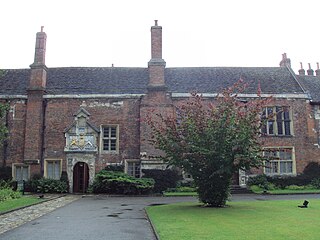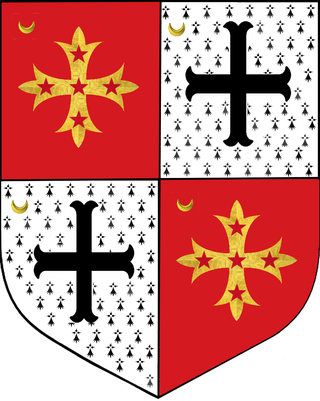Related Research Articles

The Council of the North was an administrative body first set up in 1484 by King Richard III of England,to improve access to conciliar justice in Northern England. This built upon steps by King Edward IV of England in delegating authority in the north to Richard,duke of Gloucester,and in establishing the Council of Wales and the Marches.

Thomas Fiennes,9th Baron Dacre was an English nobleman notable for his conviction and execution for murder. He was the son of Sir Thomas Fiennes and Jane,daughter of Edward Sutton,2nd Baron Dudley.

Thomas Darcy,1st Baron Darcy of Darcy or of Temple Hurst,was an English nobleman,the only son,and heir,of Sir William Darcy and his wife,Euphemia Langton,the daughter of Sir John Langton. Darcy was opposed to the Dissolution of the Monasteries,and for his role in the Pilgrimage of Grace was convicted of high treason for delivering up Pontefract Castle to the rebels. He was executed on Tower Hill 30 June 1537.
John Neville,3rd Baron Latimer was an English peer. His third wife was Catherine Parr,later queen of England.

Sir Anthony Ughtred or Oughtred,Knight banneret was an English soldier and military administrator during the reigns of Henry VII and Henry VIII. Ughtred fought in Ireland,the Anglo Scottish border and both on land and at sea in France. He served with distinction as captain of Berwick,marshal of Tournai and governor of Jersey. In 1530,he married Elizabeth Seymour,sister to Jane,future third wife to Henry VIII.
Sir Richard Tempest was an English landowner,courtier,soldier,administrator and legislator under Kings Henry VII and Henry VIII who was imprisoned after joining the Pilgrimage of Grace and died in jail.
William Robinson was one of two Members of the Parliament of England for the constituency of York between 1584 and 1586 and then again between 1588 and 1593.
Robert Brooke was one of two Members of the Parliament of England for the constituency of York between 1584 and 1586 and also between 1586 and 1588.
William Hilliard or Hildyard was one of two Members of the Parliament of England for the constituency of York between 1586 and 1588.
Hugh Graves was one of two Members of the Parliament of England for the constituency of York in 1571 and 1572.
William Holme was one of two Members of the Parliament of England for the constituency of York serving in five parliaments between 1547 and 1558.
Robert Paycock was one of two Members of the Parliament of England for the constituency of York in 1558.
William Coupland was one of two Members of the Parliament of England for the constituency of York from the November 1554 session to 1555.
John North was one of two Members of the Parliament of England for the constituency of York on two occasions between 1545–47 and October 1553 and April 1554.
Robert Hall was one of two Members of the Parliament of England for the constituency of York on two occasions between 1545–47 and October 1553 and April 1554.
John Hogeson was one of two members of the Parliament of England for the constituency of York on two occasions between 1539 and 1542 and from 1542 to 1547.
Thomas Burton was one of two Members of the Parliament of England for the constituency of York on two occasions between 1529–1533 and from 1533–1536
Thomas Drawswerd was one of two Members of the Parliament of England for the constituency of York between 1512 and 1515.
William Ormshead was one of two Members of the Parliament of England for the constituency of York on two occasions.
William Bowes was one of two Members of the Parliament of England for the constituency of York on four occasions.
References
- 1 2 3 4 "The History of Parliament Trust" . Retrieved 20 August 2021.
- ↑ Hildyard, Christopher (1719). The antiquities of York city, and the civil government thereof; with a list of all the mayors and bayliffs, lord mayors and sheriffs, from the time of King Edward the First, to this present year, 1719. Collected from the papers of Christopher Hildyard, esq., with notes and observations. G.White. p. 72.
- 1 2 P M Tillott, ed. (1961). 'Tudor York: Religion and the Reformation', in A History of the County of York: the City of York. London. pp. 142–155.
{{cite book}}: CS1 maint: location missing publisher (link) - ↑ Bastow, Sarah L. (2002). Aspects of the history of the Catholic gentry of Yorkshire from the Pilgrimage of Grace to the First Civil War. Doctoral thesis. University of Huddersfield.
- ↑ P M Tillott, ed. (1961). 'The sites and remains of the religious houses', in A History of the County of York: the City of York. London. pp. 357–365.
{{cite book}}: CS1 maint: location missing publisher (link) - ↑ P M Tillott, ed. (1961). 'Tudor York: Topography and population', in A History of the County of York: the City of York. London. pp. 117–122.
{{cite book}}: CS1 maint: location missing publisher (link)